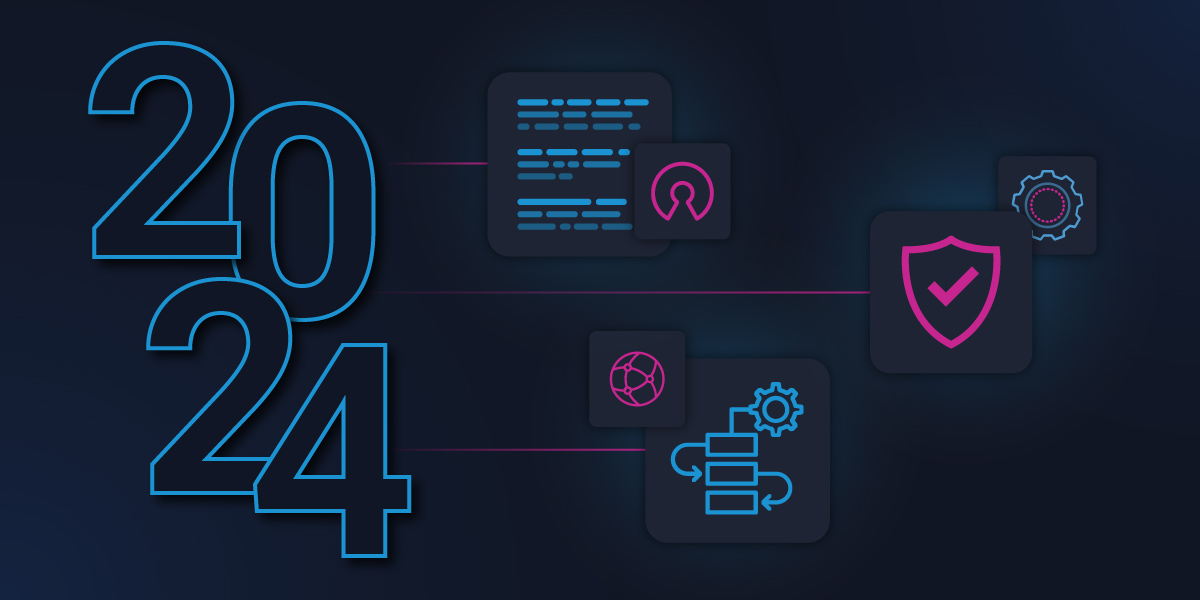Network automation has made significant strides in the past two years, with a maturing solution ecosystem, a growing culture of DIY automation among network engineers, and a greater level of focus and investment coming down from leadership teams.
Now, we are heading into a 2024 where network automation will reach yet another level of importance. This is as much due to cultural and strategic evolutions as it is technological innovation – we will see more mature automation strategies as organizations seek to accelerate network service delivery at scale.
This year, we will see network automation strategies coalesce and develop around three major trends:
- A continued proliferation of high-code, open source automation tooling from the ground up.
- Efforts to bring network validation and automation together to deliver outcomes at scale with confidence.
- The early stages of a significant mindset shift from managing individual nodes to managing network design as an entity.
Trend 1: High-Code, Open Source Tooling
Network engineers have at this point wholeheartedly embraced the high-code, open source tooling ecosystem around automating network configuration. We are seeing network teams across different industries take on automation initiatives using Python, Ansible, and Terraform, just to name a few.
This movement will grow rapidly in 2024 – it’s a fairly safe bet that, across the industry, there will be more open source projects around network automation announced in 2024 than in the last three years combined.
We are now in a world of high-code network automation engineers who are proficient with their chosen tools. The priority for IT leaders and vendors alike should be supporting this group – key considerations in this area are integrations of disparate automation tooling and the ability to orchestrate automated processes across multiple network domains.
Trend 2: Bringing Network Validation Into Automation Operating Models
Historically, network automation initiatives have focused on automating configuration changes. Recently, though, as organizations have evolved and automation approaches have matured, there is growing interest in enabling an intent-based approach to network service delivery by combining network validation and state data with configuration automation.
Validation is the key to allowing critical network operations to be automated. Today, validation is a primarily manual activity, and network engineers often spend a large portion of their time judging whether or not a given automated configuration change is having its intended effects.
Organizations are beginning to view automation as a default, the way that all network services should be delivered. To transform in this way with confidence, it is a must for validation to be incorporated into automated network changes. Validation unlocks intent-based self-service networking: automated change processes can only be delivered to end users in a zero-touch manner if validation steps are built in.
Trend 3: A Shift From Managing Nodes to Managing Network Design
Historically, even as network automation has evolved and matured, we have approached the challenge from a node-by-node perspective. We’ve thought about network automation as the process by which we automate the configuration of individual elements in the network.
However, this approach has some inherent challenges such as discrepancies between intended design and realized configuration – situations where configurations do not produce their desired outcomes despite being “correct” because of some gap in understanding the actual infrastructure involved.
A node-by-node approach will continue to present challenges as organizations progress. But what if we thought about automation from a completely different perspective? What if, instead of pushing configuration device by device, the entire design of the network — from physical infrastructure to configuration automation — were treated as a single entity?
This evolution in thinking is still in its very earliest stages. But as 2024 progresses, we will see a growing number of organizations work to reframe network automation and widen their view to encompass network design as a whole, ensuring that network automation can achieve desired technical outcomes more consistently.
What’s in a Trend? Network Automation Evolution: A Bird’s-Eye View
If we zoom out past specific trends and technologies, we can see a central theme tying everything together: we have reached a point where organizations are implementing and refining an automation-first mindset.
This cultural shift underscores everything we will see in the next year. If automation is the go-to solution, then automation must mature to the point that it can handle critical processes at scale. We’re past the point of evangelizing network automation – now, it’s time to get our hands dirty, get involved in the growing network automation community, and really start to drive the industry forward.
This blog was originally published on vmblog.com.





